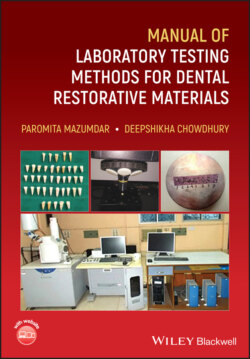Читать книгу Manual of Laboratory Testing Methods for Dental Restorative Materials - Paromita Mazumdar - Страница 5
Оглавление
Preface
Throughout our academic life either as a student, or during our role play as a teacher, instructor or supervisor for dissertation or short study designing we always felt that there was a need of a manual describing the methods and techniques for laboratory methods when we embark on a bench study. This manual may be seen as an answer to our thoughts and rigours that we faced.
A number of dental materials are used in the oral cavity for various purpose which includes restorations, endodontic treatment, orthodontic applications, surgical, and prosthodontic treatment.
Many materials used in restorative dentistry are supplied as two or more components which are eventually mixed together and undergo a chemical reaction, during which the various properties may change dramatically. The set material may be a rigid solid or a flexible rubber depending upon the chemical nature of the product. The acceptance of such a product by the dentist depends upon the properties of the unmixed paste, the properties during mixing and setting and the properties of the set material. The properties of the set material can be conveniently divided into the following categories: mechanical properties, thermal properties, chemical properties, biological properties, and other physical properties.
As post graduate trainees, researchers and practitioners, there is a need of evidence‐based application of the materials. Post graduate trainees face the difficulty of not having a clear idea about the vastness of the course and the syllabus. Also, a certain amount of time is required to gain a familiarity to the course. A thesis or a dissertation is required to be submitted for the fulfillment of the post graduate masters course and this manual will clearly enumerate the tests done to evaluate the different properties of dental materials like mechanical, physical and optical properties.
The manual consists of seven chapters based on the different properties of dental restorative materials and the mode of testing these properties. A glossary of key terms is provided separately.
Chapter 1 consists of the assessment of various mechanical properties of dental restorative materials that are commonly tested such as tensile strength, diametral compression test, compressive strength, flexural strength, resistance to fatigue, hardness, elastic modulus, fracture toughness and bond strength. Chapter 2 deals with the assessment of various physical properties such as surface roughness, water sorption, viscosity and flow, surface tension and wettability, microleakage, interfacial adaptation, film thickness, and radiopacity. Chapter 3 provides an insight into isolation and identification of oral microflora including both the culture method and the molecular biology techniques. Chapter 4 will give an idea about the assessment of biocompatibility of dental restorative materials which has been segregated based on the testing hierarchy. The different dimensions of color along with the different techniques of assessing colour of restorative materials has been detailed in Chapter 5. Chapter 6 delves into various methods of simulation of the oral environment such as the simulation of saliva, temperature change in the oral cavity, masticatory forces, pH cycling, tooth brushing and periodontium without which translational research will be incomplete. Chapter 7 provides an idea on biofilm in the oral cavity.
For researchers pertaining to dentistry or field of materials, the handbook will provide an insight into the materials used in dentistry, the properties studied, the methods used to study the properties and their respective advantages and disadvantages.
For the clinicians, this handbook will be one of its kind which will help to generate an interest and curiosity about the materials being used in individual practice.
In a nutshell, the manual on testing methods will be a helpful addition to any institute library or personal collection since this aspect of material science has never been explained before. A serious attempt at delving into the minds of young researchers has led to the conceptualization of the manuscript.
We sincerely hope the manual will add value to our intended readers.
Dr Paromita MazumdarDr Deepshikha Chowdhury
